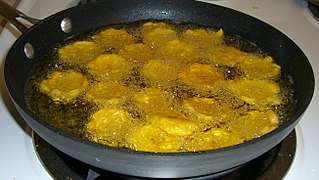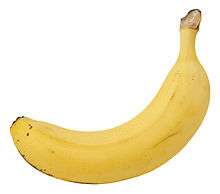Tostones
Tostones (Spanish pronunciation: [tosˈtones], from the Spanish verb tostar which means "to toast") are twice-fried plantain slices commonly found in Latin American cuisine and Caribbean cuisine. Most commonly known as tostones, Puerto Rico, Jamaica, Nicaragua, Cuba, and Venezuela), they are also known as tachinos or chatinos (Cuba), platano frito or verde frito (Dominican Republic), platano frito (Honduras), bananes pesées (Haiti), patacones (in Panama, Venezuela, Colombia, Costa Rica, Peru, and Ecuador) and, sometimes, patacón pisao in Colombia[1][2].
 Tostones being cooked | |||||||
| Alternative names | Patacones | ||||||
|---|---|---|---|---|---|---|---|
| Type | Side Dish | ||||||
| Region or state | Latin America and Caribbean | ||||||
| Main ingredients | Unripe plantains, oil | ||||||
| Ingredients generally used | Salt, other seasonings | ||||||
| 92 kcal (385 kJ) | |||||||
| |||||||
Preparation
Green (unripe) plantains are peeled, sliced length-wise, diagonally, or width-wise, and then fried twice.[3] The raw slices of plantains are fried for one to two minutes on each side until they are golden in color, and removed and patted to remove excess cooking oil. Afterward, they are pounded flat with a hinged utensil made for the task, called a tostonera, or less conveniently with any kitchen utensil that has a large enough flat surface, for instance between two plates. The flattened plantain slices are then fried once again until they are crisp and golden brown.
Origin
It's unclear on where this recipe originated from but most believe its Puerto Rican. Tostones are said to be "The Puerto Rican equivalent of the French pommoes soufflés". It's also said that they were created by Doña Angelina, who was a cook at Los Robles Restaurant in Salinas, Puerto Rico. Early Jibaro music and poetry talk about a side dish known today as tostones. It is closely related to other fried plantain dishes in Puerto Rico such as pionono, mofongo, arañitas (fried shredded plantains), alcapurria (stuffed plantain fritters), and tostones de pana (twice fried breadfruit).
Serving
Tostones are salted and eaten much like potato chips/crisps or French fries/chips. In some regions, it is customary to dip them in mojo (a garlic sauce) or ají. In Colombia they are sometimes served with hogao sauce[1] or topped with seasoned shredded beef.[2] In Costa Rica, they are often eaten with a paste-like dip made from black beans. In the Dominican Republic, they are commonly served with fresh lime wedges to squeeze over them and salt for sprinkling. In Guatemala on the Caribbean side, they are usually served as a side when you order fish or any type of poultry. Normally sprinkled with a little salt. In some countries, they are served topped with cheese as an appetizer, or with shrimp ceviche, pulled chicken, or avocado salad.[4] They can also be bought prepared from supermarkets. This food is found in all varieties of Caribbean cuisine. In Nicaragua they're typically served with fried cheese and sometimes with refried beans.
Tostones are also a staple of Latin American countries and the Caribbean, including Cuba, Puerto Rico, Dominican Republic, Panama, the north coast of Honduras, and in Haiti, where they are often served with the traditional griot (fried pork) or picklise (pikliz) - a pickled hot pepper mix.
They can also be found in West African cuisine, where they are referred to as plantain crisps.
Other uses of the term
In Honduras, the term tostón may also refer to the 50-cent coin of the local currency, the lempira. This is also the case in Mexico in 50 cents of a peso.
In the Dominican Republic, tostones are chunks of plantains fried once.
References
- "Patacón pisao • Periódico El Campesino – La voz del campo colombiano". www.elcampesino.co (in Spanish). Retrieved 2018-09-28.
- minue (2013-03-12). "Patacón pisao. Receta colombiana" (in Spanish). Retrieved 2018-09-28.
- "Garlic Tostones: Puerto Rican Fried Plantains with Rice and Beans - Pinch of Yum". 13 December 2013.
- "Home - Chiquita". www.chiquitabananas.com.
